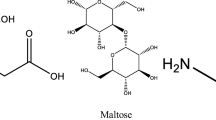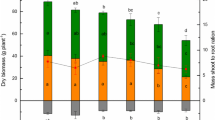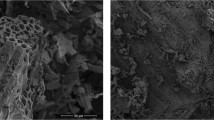Abstract
Pennisetum grasses (P. purpureum Schumach. ‘Purple’, P. alopecuroides (L.) Spreng. ‘Liren’ and P. alopecuroides (L.) Spreng. ‘Changsui’), and a cadmium (Cd) hyperaccumulator (Thlaspi caerulescens J.Presl & C.Presl), were grown in soil with four Cd addition levels of 0, 2, 20 and 200 mg/kg. Toxicity symptoms were not observed although growth of all plants decreased as Cd addition increased. Shoot bioconcentration factor (BCFS), the translocation factor (TF) and shoot accumulation of Cd for most plants first increased and then declined as Cd concentrations increased. In contrast, the root bioconcentration factor (BCFR) for T. caerulescens declined and root Cd accumulation for T. caerulescens and two P. alopecuroides cultivars increased consistently as Cd levels increased. P. purpureum had the largest biomass with shoot Cd accumulation similar to that of T. caerulescens, despite lower foliar Cd concentration. Although shoot Cd concentrations of two P. alopecuroides cultivars were lower than for P. purpureum, root Cd concentrations were greater. P. purpureum had Cd BCFS and TF (> 1) at 2- and 20-mg/kg Cd addition treatments, similar to T. caerulescens. P. alopecuroides cultivars had Cd BCFR (> 1) and TF (< 1) at all Cd levels. Roots did not affect rhizosphere pH. However, concentrations of acid extractable Cd in rhizosphere soil were lower than those of corresponding non-rhizosphere soil at all Cd levels for T. caerulescens and P. purpureum; T. caerulescens and P. purpureum did not affect less bioavailable Cd fractions. Concentrations of acid extractable Cd in the rhizosphere of the P. alopecuroides cultivars were not reduced at any Cd level. Differences in Cd accumulation among the three Pennisetum grasses were mainly attributable to root biomass and Cd TFs rather than rhizosphere Cd mobility.





Similar content being viewed by others
References
Chen YH, Liu MJ, Deng YW, Zhong F, Xu B, Hu L, Wang M, Wang G (2017) Comparison of ammonium fertilizers, EDTA, and NTA on enhancing the uptake of cadmium by an energy plant, Napier grass (Pennisetum purpureum Schumach). J Soils Sediments 17(12):2786–2796. https://doi.org/10.1007/s11368-017-1703-7
Chen ZQ, Liu X, Ai YW, Chen J, Luo X, Chen J, Zhong S (2018) Effects and mechanisms of revegetation modes on cadmium and lead pollution in artificial soil on railway rock-cut slopes. Sci Total Environ 644:1602–1611. https://doi.org/10.1016/j.scitotenv.2018.06.380
Cheraghi M, Lorestani B, Khorasani N, Yousefi N, Karami M (2011) Findings on the phytoextraction and phytostabilization of soils contaminated with heavy metals. Biol Trace Elem Res 144(1–3):1133–1141. https://doi.org/10.1007/s12011-009-8359-0
Christensen TH (1984) Cadmium soil sorption at low concentrations: I. Effect of time, cadmium load, pH, and calcium. Water Air Soil Pollut 21:105–114. https://doi.org/10.1007/BF00163616
Clemens S (2001) Molecular mechanisms of plant metal tolerance and homeostasis. Planta 212:475–486. https://doi.org/10.1007/s004250000458
Ding Z, Fang Q, Daraz U, Sun Q (2021) Physiological responses and metal distributions of different organs of Phragmites australis shoots under acid mine drainage stress. Environ Sci Pollut Res 28:3375–3385. https://doi.org/10.1007/s11356-020-10700-8
EFSA (European Food Safety Authority) (2009) Scientific opinion on cadmium in food. ESFA Journal 980:1–139. https://doi.org/10.2903/j.efsa.2009.980
Gong XM, Huang DL, Liu YG, Zeng G, Wang R, Wei J, Huang C, Xu P, Wan J, Zhang C (2018) Pyrolysis and reutilization of plant residues after phytoremediation of heavy metals contaminated sediments: for heavy metals stabilization and dye adsorption. Bioresour Technol 253:64–71. https://doi.org/10.1016/j.biortech.2018.01.018
Guo HP, Hong CT, Chen XM, Xu Y, Liu Y, Jiang D, Zheng B (2016) Different growth and physiological responses to cadmium of the three Miscanthus species. PLoS One 11(4):1534–1575. https://doi.org/10.1371/journal.pone.0153475
Guo HP, Feng X, Hong CT, Chen H, Zeng F, Zheng B, Jiang D (2017) Malate secretion from the root system is an important reason for higher resistance of Miscanthus sacchariflorus to cadmium. Physiol Plant 159(3):340–353. https://doi.org/10.1111/ppl.12526
Hasnaoui SE, Fahr M, Keller C, Levard C, Angeletti B, Chaurand P, Triqui ZEA, Guedira A, Rhazi L, Colin F, Smouni A (2020) Screening of native plants growing on a Pb/Zn mining area in Eastern Morocco: perspectives for phytoremediation. Plants 9:1458. https://doi.org/10.3390/plants9111458
He JY, Wang YY, Ren YF et al (2009) Effect of cadmium on root morphology and physiological characteristics of rice seedlings. Ecol Environ Sci 18(5):1863–1868 (in Chinese. https://doi.org/10.16258/j.cnki.1674-5906.2009.05.023
Hou X, Teng W, Hu Y et al (2020) Potential phytoremediation of soil cadmium and zinc by diverse ornamental and energy grasses. Bioresources 15(1):616–640. https://doi.org/10.15376/biores.15.1.616-640
Huang YY, He CT, Shen C, Guo J, Mubeen S, Yuan J, Yang Z (2017) Toxicity of cadmium and its health risks from leafy vegetable consumption. Food Funct 8(4):1373–1401. https://doi.org/10.1039/C6FO01580H
Huang L, Wang Q, Zhou Q, Ma L, Wu Y, Liu Q, Wang S, Feng Y (2020) Cadmium uptake from soil and transport by leafy vegetables: a meta-analysis. Environ Pollut 264:114677. https://doi.org/10.1016/j.envpol.2020.114677
Hussain B, Ashraf MN, Rahman S-U et al (2021) Cadmium stress in paddy fields: effects of soil conditions and remediation strategies. Sci Total Environ 754:142188. https://doi.org/10.1016/j.scitotenv.2020.142188
Jacobs A, Noret N, Baekel AV et al (2019) Influence of edaphic conditions and nitrogen fertilizers on cadmium and zinc phytoextraction efficiency of Noccaea caerulescens. Sci Total Environ 665:649–659. https://doi.org/10.1016/j.scitotenv.2019.02.073
Jing F, Chen C, Chen X, Liu W, Wen X, Hu S, Yang Z, Guo B, Xu Y, Yu Q (2020) Effects of wheat straw derived biochar on cadmium availability in a paddy soil and its accumulation in rice. Environ Pollut 257:113592. https://doi.org/10.1016/j.envpol.2019.113592
Kabata-Pendias A (1995) Agricultural problems related to excessive trace metal contents of soils. In: Förstner U, Salomons W, Mader P (eds) Heavy Metals. Springer, Berlin Heidelberg, pp 3–18
Kanwar VS, Sharma A, Srivastav AL, Rani L (2020) Phytoremediation of toxic metals present in soil and water environment: a critical review. Environ Sci Pollut Res 27:44835–44860. https://doi.org/10.1007/s11356-020-10713-3
Ko CH, Yu FC, Chang FC, Yang BY, Chen WH, Hwang WS, Tu TC (2017) Bioethanol production from recovered napier grass with heavy metals. J Environ Manag 203(3):1005–1010. https://doi.org/10.1016/j.jenvman.2017.04.049
Li ZR, Wang JX, An LZ, Tan JB, Zhan FD, Wu J, Zu YQ (2019) Effect of root exudates of intercropping Vicia faba and Arabis alpina on accumulation and sub-cellular distribution of lead and cadmium. International Journal of Phytoremediation 21(1):4–13. https://doi.org/10.1080/15226514.2018.1523867
Liu LW, Li W, Song WP, Guo M (2018) Remediation techniques for heavy metal-contaminated soils: principles and applicability. Sci Total Environ 633:206–219. https://doi.org/10.1016/j.scitotenv.2018.03.161
Liu S, Ali S, Yang R, Tao J, Ren B (2019) A newly discovered Cd-hyperaccumulator Lantana camara L. J Hazard Mater 371:233–242. https://doi.org/10.1016/j.jhazmat.2019.03.016
Lombi E, Zhao FJ, Dunham SJ et al (2000) Cadmium accumulation in populations of Thlaspi caerulescens and Thlaspi goesingense. New Phytol 145(1):11–20. https://doi.org/10.1046/j.1469-8137.2000.00560.x
Lombi E, Zhao FJ, McGrath SP et al (2001) Physiological evidence for a high-affinity cadmium transporter highly expressed in a Thlaspi caerulescens ecotype. New Phytol 149(1):53–60. https://doi.org/10.1046/j.1469-8137.2001.00003.x
Lorenz SE, Hamon RE, McGrath SP (1994) Differences between soil solutions obtained from rhizosphere and non-rhizosphere soils by water displacement and soil centrifugation. Eur J Soil Sci 45:431–438. https://doi.org/10.1111/j.1365-2389.1994.tb00528.x
Lu RK (2000) Soil agricultural chemical analysis method. China Agriculture Science and Technique Press, Beijing
McGrath SP, Zhao FJ (2003) Phytoextraction of metals and metalloids from contaminated soils. Curr Opin Biotechnol 14(3):277–282. https://doi.org/10.1016/S0958-1669(03)00060-0
Papazoglou EG, Karantounias GA, Vemmos SN, Bouranis DL (2005) Photosynthesis and growth responses of giant reed (Arundo donax L.) to the heavy metals Cd and Ni. Environ Int 31(2):243–249. https://doi.org/10.1016/j.envint.2004.09.022
Phusantisampan T, Meeinkuirt W, Saengwilai P, Pichtel J, Chaiyarat R (2016) Phytostabilization potential of two ecotypes of Vetiveria zizanioides in cadmium-contaminated soils: greenhouse and field experiments. Environ Sci Pollut Res 23(19):20027–20038. https://doi.org/10.1007/s11356-016-7229-5
Pinto AP, Mota AM, de Varennes A et al (2004) Influence of organic matter on the uptake of cadmium, zinc, copper and iron by sorghum plants. Sci Total Environ 326(1–3):239–247. https://doi.org/10.1016/j.scitotenv.2004.01.004
Qin S, Liu H, Nie Z et al (2020) Toxicity of cadmium and its competition with mineral nutrients for uptake by plants: a review. Pedosphere 30(2):168–180. https://doi.org/10.1016/S1002-0160(20)60002-9
Reeves RD, Baker AJM, Jaffré T, Erskine PD, Echevarria G, Ent A (2017) A global database for plants that hyperaccumulate metal and metalloid trace elements. New Phytol 218(2):407–411. https://doi.org/10.1111/nph.14907
Robinson BH, Leblanc M, Petit D, Brooks RR, Kirkman JH, Gregg PEH (1998) The potential of Thlaspi caeurulescens for phytoremediation of contaminated soils. Plant Soil 203(1):47–56. https://doi.org/10.1023/A:1004328816645
Salas-Moreno M, Marrugo-Negrete J (2020) Phytoremediation potential of Cd and Pb-contaminated soils by Paspalum fasciculatum Willd. ex Flüggé. International Journal of Phytoremediation 22(1):87–97. https://doi.org/10.1080/15226514.2019.1644291
Sarwar N, Imran M, Shaheen MR, Ishaque W, Kamran MA, Matloob A, Rehim A, Hussain S (2017) Phytoremediation strategies for soils contaminated with heavy metals: modifications and future perspectives. Chemosphere 171:710–721. https://doi.org/10.1016/j.chemosphere.2016.12.116
Sterckeman T, Goderniaux M, Sirguey C, Cornu JY, Nguyen C (2015) Do roots or shoots control cadmium accumulation in the hyperaccumulator Noccaea caerulescens? Plant Soil 392:87–99. https://doi.org/10.1007/s11104-015-2449-x
Tian RN, Yu S, Wang SG, Zhang Y, Tang JY, Liu YL, Nie YH (2013) Heavy metal tolerance and accumulation of Triarrhena sacchariflora, a large amphibious ornamental grass. Water Sci Technol 68(8):1795–1800. https://doi.org/10.2166/wst.2013.424
Ververis C, Georghiou K, Christodoulakis N, Santas P, Santas R (2004) Fiber dimensions, lignin and cellulose content of various plant materials and their suitability for paper production. Ind Crop Prod 19(3):245–254. https://doi.org/10.1016/j.indcrop.2003.10.006
Xu L, Xing XY, Liang JN, Peng J, Zhou J (2019) In situ phytoremediation of copper and cadmium in a co-contaminated soil and its biological and physical effects. RSC Adv 9(2):993–1003. https://doi.org/10.1039/C8RA07645F
Yang WJ, Gu JF, Zhou H, Huang F, Yuan TY, Zhang JY, Wang SL, Sun ZG, Yi HW, Liao BH (2020) Effect of three Napier grass varieties on phytoextraction of Cd- and Zn-contaminated cultivated soil under mowing and their safe utilization. Environ Sci Pollut Res 27:16134–16144. https://doi.org/10.1007/s11356-020-07887-1
Yi X, Lai Z, Yao N et al (2016) Planting performance of Pennisetum purpureum Schumab cv. Purple in the southern region of China. Agric Sci Technol 17(3):667–671. https://doi.org/10.16175/j.cnki.1009-4229.2016.03.041
Yoon J, Cao XD, Zhou QX, Ma LQ (2006) Accumulation of Pb, Cu, and Zn in native plants growing on a contaminated Florida site. Sci Total Environ 368(2–3):456–464. https://doi.org/10.1016/j.scitotenv.2006.01.016
Yu BH, Peng YJ, Xu JR, Qin D, Gao T, Zhu H, Zuo S, Song H, Dong J (2020) Phytoremediation potential of Youngia japonica (L.) DC: a newly discovered cadmium hyperaccumulator. Environ Sci Pollut Res 28:6044–6057. https://doi.org/10.1007/s11356-020-10853-6
Zhang XF, Xia HP, Li ZA, Zhuang P, Gao B (2010a) Potential of four forage grasses in remediation of Cd and Zn contaminated soils. Bioresour Technol 101(6):2063–2066. https://doi.org/10.1016/j.biortech.2009.11.065
Zhang X, Zhang S, Xu X, Li T, Gong G, Jia Y, Li Y, Deng L (2010b) Tolerance and accumulation characteristics of cadmium in Amaranthus hybridus L. J Hazard Mater 180:303–308. https://doi.org/10.1016/j.jhazmat.2010.04.031
Zhao FJ, Hamon RE, McLaughlin MJ (2001) Root exudates of the hyperaccumulator Thlaspi caerulescens do not enhance metal mobilization. New Phytol 151(3):613–620. https://doi.org/10.1046/j.0028-646x.2001.00213.x
Zhao FJ, Hamon RE, Lombi E, McLaughlin MJ, McGrath SP (2002) Characteristics of cadmium uptake in two contrasting ecotypes of the hyperaccumulator Thlaspi caerulescens. J Exp Bot 53(368):535–543. https://doi.org/10.1093/jexbot/53.368.535
Zhao FJ, Lombi E, McGrath SP (2003) Assessing the potential for zinc and cadmium phytoremediation with the hyperaccumulator Thlaspi caerulescens. Plant Soil 249:37–43. https://doi.org/10.1023/A:1022530217289
Zhao FJ, Ma Y, Zhu YG, Tang Z, McGrath SP (2015) Soil contamination in China: current status and mitigation strategies. Environ Sci Technol 49(2):750–759. https://doi.org/10.1021/es5047099
Zheng R, Li H, Jiang R, Römheld V, Zhang F, Zhao FJ (2011) The role of root hairs in cadmium acquisition by barley. Environ Pollut 159(2):408–415. https://doi.org/10.1016/j.envpol.2010.10.034
Zheng RL, Cai C, Liang JH, Huang Q, Chen Z, Huang YZ, Arp HPH, Sun GX (2012) The effects of biochars from rice residue on the formation of iron plaque and the accumulation of Cd, Zn, Pb, As in rice (Oryza sativa L.) seedlings. Chemosphere 89:856–862. https://doi.org/10.1016/j.chemosphere.2012.05.008
Zheng R, Li C, Sun GX, Xie Z, Chen J, Wu J, Wang Q (2017) The influence of particle size and feedstock of biochar on the accumulation of Cd, Zn, Pb, and As by Brassica chinensis L. Environ Sci Pollut Res 24(28):22340–22352. https://doi.org/10.1007/s11356-017-9854-z
Zhong LS, Lin LJ, Liao MA et al (2019) Phytoremediation potential of Pterocypsela laciniata as a cadmium hyperaccumulator. Environ Sci Pollut Res 26(13):13311–13319. https://doi.org/10.1007/s11356-019-04702-4
Availability of data and materials
The datasets used and/or analysed during the current study are available from the corresponding author on reasonable request.
Funding
This work was financially supported by a grant (No. BB/M027945/1) from BBSRC research collaboration project ‘China-UK consortium to reduce environmental pollution with novel grass varieties’, National Natural Science Foundation of China (No. 41501336) and the Beijing Academy of Agriculture and Forestry Sciences (KJCX20200210, SYJJ202001 and KJCX20170411).
Author information
Authors and Affiliations
Contributions
RZ, WT, YH and JW have designed the experiment; RZ, WT, YH, XH, DS and XT have performed the experiments; WT have performed plant propagation; RZ, JW and JS have analysed the data and written the manuscript. All authors have actively participated to the writing of the manuscript and approved the final manuscript.
Corresponding author
Ethics declarations
Ethics approval and consent to participate
Not applicable
Consent for publication
Not applicable
Competing interests
The authors declare no competing interests.
Additional information
Responsible Editor: Elena Maestri
Publisher’s note
Springer Nature remains neutral with regard to jurisdictional claims in published maps and institutional affiliations.
Supplementary Information
ESM 1
(DOCX 59 kb)
Rights and permissions
About this article
Cite this article
Zheng, ., Teng, W., Hu, Y. et al. Cadmium uptake by a hyperaccumulator and three Pennisetum grasses with associated rhizosphere effects. Environ Sci Pollut Res 29, 1845–1857 (2022). https://doi.org/10.1007/s11356-021-15043-6
Received:
Accepted:
Published:
Issue Date:
DOI: https://doi.org/10.1007/s11356-021-15043-6




